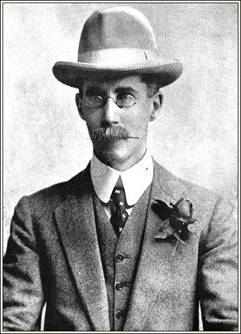
Major
HERBERT ROWSE ARMSTRONG, TD
Royal Engineers
By
Lieutenant
Colonel Edward De Santis, MSCE, P.E., MInstRE
(U.S. Army Corps of Engineers)
(May 2022)

Figure
1. Herbert Rowse Armstrong, TD.
(Photograph courtesy of Wikipedia)
The Military Service of a
MURDERER
Introduction
Herbert Rowse Armstrong was by no means an outstanding example of an
officer of the Royal Engineers. He
was a philander, a cheat, a thief and a murderer.
I became interested in him when I happened to find a copy of EXHUMATION OF A MURDER: The Life and Trial of Major Armstrong by
Robin Odell.[i]
As a student of British military history I was intrigued by the title.
My special area of interest is the Royal Engineers of the British Army,
and you can imagine my delight when within the first few pages of the book I
found that Major Armstrong had indeed served in the Royal Engineers.
I was determined then to write this narrative concentrating primarily on
his military career. The details of
his crimes, prosecution and ultimately his execution have been thoroughly
covered by many books and internet web site, so their mention in this narrative
will be only in passing.
Early
Service in the Volunteer Corps
Herbert
Rowse Armstrong was born in the Teignbridge District of Newton Abbott,
Devonshire on 13 May 1869.[ii]
He attended St. Catherine’s College of the University of Cambridge,
matriculating in 1887.[iii]
On 28 November 1900 Armstrong began his military service as a Lieutenant in the
1st Lancashire Royal Engineers (Volunteers),[iv]
a unit formed in Liverpool on 1 October 1860.
As an officer of the Royal Engineers (Volunteers) he was not a full-time
soldier. While serving in the unit
he practiced as a solicitor in civilian life.
On 5 February 1902 he transferred from the 1st Lancashire R.E.
(V) to the 1st Devonshire and Somersetshire Royal Engineers
(Volunteers) with its headquarters at Exeter, Devonshire.[v]
He was appointed Captain in this unit on 5 October 1904.[vi]
His soldierly ambitions had helped to gain him this rank in the Volunteer
Forces. He had thrown himself
wholeheartedly into the life of the
pre-war territorial army, attending regular camps and diligently sitting the
examinations which would secure future promotions.
The desire to be an officer and a gentleman and to associate with men of
high rank in the local social structure was a strong urge in Armstrong.
He became a member of the Order of Freemasons and completed the trio of
interests that dominated his life: Army, Church and Freemasonry.[vii]
Here a review of the history of the Engineer Volunteer Corps (EVC) may be
of interest. The enthusiasm for the
Volunteer movement following an invasion scare in 1859 led to the creation of
many Rifle, Artillery and Engineer Volunteer units composed of part-time
officers and soldiers eager to supplement the Regular Army in time of need.
One such unit was the 1st Devonshire Engineer Volunteer Corps formed at Torquay.
The 1st Devonshire EVC was attached for administrative purposes to
the 1st (Exeter and South Devon) Devonshire Rifle Volunteer Corps.
In August 1889, the Devon and Somerset companies were removed from the
Rifle Volunteer Corps as a separate unit known as the 1st
Devonshire and Somersetshire RE (V), with its headquarters at the Priory,
Colleton Crescent, Exeter. The 1st
Devonshire and Somerset RE (V) sent a detachment of one officer and 25 other
ranks to assist the regular units of the Royal Engineers during the Second Boer
War in 1900, and a second section the following year.
Armstrong was not in either of these sections.
Service
in the Infantry
For some strange reason Armstrong was transferred from the Royal
Engineers to the infantry in 1908. This
may not have to his liking as he was a small and rather meek looking individual
who did not seem suited to be an infantry officer.
On 1 April 1908 he was transferred to The Brecknockshire Battalion, The
South Wales Borderers from the Devonshire and Somersetshire Royal Engineers
(Volunteers). He retained his rank
as a Captain with precedence as in the Volunteer Force and was designated to be
a supernumerary.[viii]
His presence in a battalion where no vacancy existed for him may have
been due to his relocation to Wales to practice his business as a solicitor.
This assumption is backed by his move in 1912 to Hay-on-Wye in Wales as
part of “D” Detachment of The Brecknockshire Battalion.[ix]
In supernumerary capacity it is most likely that he had little or nothing to do
with the battalion’s training, or if he did, he simply shadowed another
infantry officer who actually was active in the battalion’s operations.
Service
During the Great War
On 20 October 1914 Armstrong was transferred from The South Wales
Borderers back to the Royal Engineers as a result of the outbreak of the Great
War in August 1914. He retained his
rank of Captain and was posted to the 1st Wessex Field Company, Royal
Engineers in the 43rd (1st Wessex) Division.
The company’s headquarters was located at The Drill Hall, Upper Bristol
Road in Bath, Somerset.[x]
Armstrong was made the Adjutant of the 1st Wessex Field
Company. He was engaged mainly in
administrative duties for which his professional background ideally suited him.
For a period he also served as the Adjutant of the 2/1 Wessex Divisional
Engineers at Ilford Camp, near Bournemouth in Dorset.
This appointment at a higher headquarters was likely due to the
relatively long period of time that he had spent with the Royal Engineers
Volunteers and his seniority as a Captain.[xi]
Postings such as these enabled him to keep in touch with business affairs
in Hay.
Armstrong was an egoist who constantly needed acclaim.
In his book, Robin Odell wrote:
“Letters
written to him by senior contemporary officers pay glowing tributes to
Armstrong’s efficiency: ‘I can say that as far as I was concerned, as
Adjutant I always found your unit run in a most capable way . . . I have no
hesitation in saying that during the time you were with the 58th Div.
the administration and training was always most satisfactory’, wrote one
correspondent. Another said, ‘I do
recollect the excellent condition your portion of the camp was always in and has
always been a pleasure to come to see it on my tours of inspection.’
Unfortunately Odell does not cite references for these testimonials.
The first is of interest because it appears that Armstrong had served for
some time in the British 58th Division.
The 58th (2/1st London) Division was concentrated
in Ipswich until January of 1917 when it embarked for France.
It contained two Wessex Field Companies of the Royal Engineers, the 2/1st
Wessex (later the 503rd) Field Company and the 2/2nd
Wessex (later the 504th) Field Company.
Armstrong is known to have served in the 1st Wessex Field
Company of the 43rd (Wessex) Division, so it is not known if or how
he was involved with the 58th Division.
The second comment in Odell’s book probably refers to Armstrong’s
company camp, which he as Adjutant of the company would have been responsible
for setting up and maintaining its facilities.
The comment probably was made by the 43rd Division’s
Commander Royal Engineers (CRE) who would have been responsible for such
inspections.
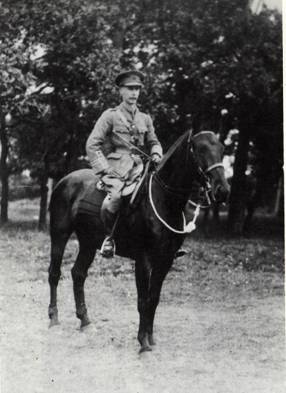
Figure
2. Captain Armstrong on the Eve of
the Great War.
(Photograph from “Exhumation of a Murder.”
On 29 July 1914, the 43rd (Wessex) Division was on Salisbury Plain carrying out its annual training camp when 'precautionary orders' were received, and next day the division took up emergency war stations in Somerset, Devon and Cornwall. The order to mobilize arrived on the evening of 4 August. Between 10 and 13 August the division concentrated on Salisbury Plain and began war training, but as indicated above Armstrong did not join his company until October.
On 24 September 1914, at the special request of the Secretary of State
for War, Earl Kitchener of Khartoum the 43rd (Wessex) Division
accepted liability for service in British India to relieve the Regular Army
units there for service on the Western Front. The division's infantry battalions
(without their brigade headquarters) and artillery brigades embarked at
Southampton on 8 October and were convoyed to Bombay, disembarking on 9
November. The engineers, medical units, transport, heavy battery and brigade
ammunition columns remained in the UK and joined formations composed of Regular
units brought back from India and other imperial garrisons; thus, Armstrong did
not go to India.[xii]
He vacated his appointment as Adjutant of the 43rd (Wessex)
Divisional Engineers on 31 December 1915 but he remained with the 1st
Wessex Field Company, at least for a while.[xiii]
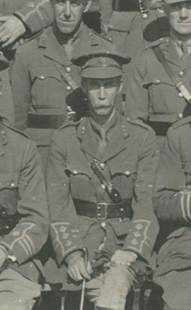
Figure
3. Captain Armstrong in the 1st
Wessex Field Company, R.E.
(Photograph courtesy of Simon Fielding in the Great War Forum)
On 1 June 1916, exactly one month prior to the start of the great British offensive on the Somme, Armstrong was promoted to Major.[xiv] Fortunately for him Armstrong was still in England at the time and took no part in the slaughtered that transpired on 1 July 1916. After serving most of the war in England, Armstrong finally got the opportunity to see active service for three months at the tail end of the war. He went to France in May of 1918 but he did not serve at the front. He was engaged in routine duties at the Royal Engineers Base Depot and some gas warfare training at the Base Training Camp at Rouen in September 1918. He returned home in October.[xv]
During his time in France Armstrong apparently wrote home to his wife that he worked eight hours, six days a week with only Sundays off. He claimed to be 1½ miles behind the lines, bombs and shells from air raids continually over him and that one day he rode unwillingly to a village that was under fire.[xvi]
Post
War Service
Major Armstrong was demobilized in May 1919 and he returned to Hay-on-Wye where he resumed his law practice and commanded the company of ex-servicemen that took part in the unveiling ceremony of the Hay War Memorial. His commanding officer made the following entry in Armstrong’s Army Book 439 at the time of his demobilization:[xvii]
“This officer is very well suited for duty in a department of the Provost Marshal . . . and I have every confidence in recommending Major H. Rowse Armstrong for the appointment of Area Commandant. His administrative training makes him particularly suitable for a post of this kind.”
Armstrong was awarded the Territorial Decoration on 4 November 1919.[xviii] On 15 December 1920 Armstrong, still with the 43rd (Wessex) Divisional Engineers, was assigned to the Territorial Force Reserve as a Major.[xix] He was retired from the Army (Territorial Force Reserve) on 30 June 1921, having reached the age limit for service. He was granted permission to retain his rank.[xx] He used the title of Major in all of his business dealings and when identifying himself in public.[xxi]
Armstrong applied for his Great War Medals on 10 July 1921. His medal index card shows that the medals were forfeited, presumably because of his arrest for murder and attempted murder.
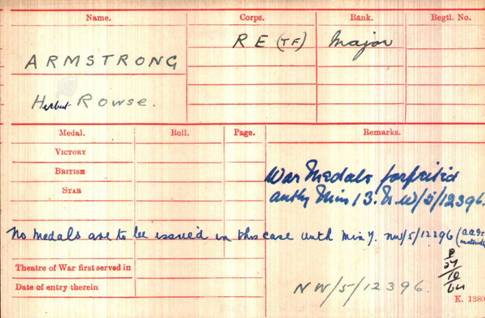
Figure
4. Medal Index Card of Major Herbert
Rowse Armstrong, R.E.
(Image courtesy of Ancestry.com)
Armstrong’s Medal Index Card differs from the norm in that it does not show to which medals he would have been entitled had he been awarded them. It also does not show the “Theatre of War first served in” which would have been France, or the “Date of entry therein.” The card clearly shows that his War Medals had been forfeited. During this research it could not be determined if his Territorial Decoration had been rescinded as well.
Epilogue
To close the story of Armstrong’s military service life it seems proper to quickly summarize his life. Herbert Rowse Armstrong was a fifty two year old solicitor practicing in the Welsh border town of Hay-on-Wye. A seemingly mild mannered man he was a retired army Major. His wife was well known as a hypochondriac and a nag. One way he had found to get away from her was to become involved in the Territorial Army, rising to the rank of Major. When this did not give him the amount of freedom that he wanted he started to think of something more permanent.
Although she was a hypochondriac she really had been ill and when she died it was believed to be from Gastritis. Had the doctor examined her more closely he may have realised that she had not died from Gastritus but from arsenical poisoning. She was buried and that might have been the end of it had it not been for the fact that having once gotten away with it Armstrong decided to use the same method again.
After a dispute with a rival solicitor named Oswald Martin, Armstrong
invited him to tea on the pretence of finding a solution to a dispute between
them. Martin was passed a scone which had been heavily laced with arsenic The
effect of this was to make Martin violently ill on his return home. Martin’s
father in law was the town’s chemist and was aware of the purchases that
Armstrong had made of arsenic. Tests were done and the authorities notified.
Armstrong was arrested on suspicion of attempted murder and murder of his wife.
Her body was exhumed. Arsenic
can remain in the body of a dead person for years and can even help to preserve
the body.
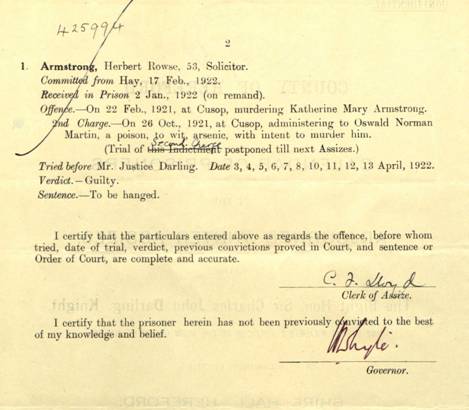
Figure
5. Armstrong’s Charge Sheet (Gloucester Prison Calendar)
(Image
courtesy of Wikipedia)
He was tried at Hereford Assizes and found guilty and held at Gloucester Prison until he was hanged at 8 am on 31 May 1922 by the official Hangman John Ellis. As to the reason for Armstrong to murder his wife it would seem that Armstrong saw murder as a way of getting out of an unhappy marriage and this was indeed his motive.
REFERENCES
Army Lists
1.
Monthly Army List, June 1903, p. 471.
2.
Monthly Army List, June 1907, p. 471.
3.
Monthly Army List, February 1915, p. 833.
4.
Monthly Army List, April 1915, p. 832.
5.
Monthly Army List, December 1920, p. 830.
Books
1.
ODELL, R.
EXHUMATION OF A MURDER.
The Life and Trial of Major Armstrong.
St. Martin’s Press, New York, 1975 and 1988.
2.
The War List of the University of Cambridge, p. 307.
3.
Record of Service of Solicitors and Articled Clerks, 1914-1919.
Documents
Prison
Calendar, Gloucester Prison, 2 January 1922.
Family Tree
Herbert
Rowse Armstrong (Ammon Crook)
https://www.ancestry.com/facts?_phcmd=u(%27https://www.ancestry.com/search/
Internet Web
Sites
1.
1st Somersetshire Engineers
https://en.wikipedia.org/wiki/1st_Somersetshire_Engineers
2.
43rd (Wessex) Infantry Division
https://en.wikipedia.org/wiki/43rd_(Wessex)_Infantry_Division
London Gazette
1.
The London Gazette, 20 September, 1892, p. 5347.
2.
The London Gazette, November 27, 1900, p. 7827.
3.
The London Gazette, February 4, 1902, p. 721.
4.
The London Gazette, October 4, 1904, p. 6369.
5.
The London Gazette, March 2, 1909, p. 1663.
6.
The London Gazette, 3 November 1914, p. 8890.
7.
Supplement to the London Gazette, 17 August 1916, p. 8116.
8.
Supplement to the London Gazette, 30 July 1917, p. 7785.
9.
Supplement to the London Gazette, 22 September 1917, p. 9841.
10.
Supplement to the London Gazette, 4 November 1919, p. 13518.
11.
Supplement to the London Gazette, 14 December 1920, p. 12368.
12.
Supplement to the London Gazette, 30 June 1921, p. 5220.
Military Records
Army Book 439 (Officer’s Record of Service Book).
ENDNOTES
[i] St. Martin’s Press, N.Y., 1975 and 1988.
[ii]
Armstrong Family Tree.
[iii]
The War List of the University of Cambridge.
[iv]
London Gazette, 27 November 1900.
[v]
London Gazette, 4 February 1902.
[vi]
London Gazette, 4 October 1904.
[vii] ODELL, R., 1988, p. 10.
[viii]
London Gazette, 2 March 1909.
[ix]
ODELL, R., 1988, p. 9.
[x]
London Gazette, 3 November 1914 and 31 July 1917.
[xi]
The Monthly Army List, April 1915.
[xii]
43rd (Wessex) Division web site (Wikipedia).
[xiii]
London Gazette, 17 August 1916.
[xiv]
London Gazette, 22 September 1917.
[xv]
Army Book 439.
[xvi] ODELL, R., 1988, p. 13.
[xvii] Ibid.
[xviii]
London Gazette, 4 November 1919.
[xix]
London Gazette, 14 December 1920.
[xx]
London Gazette, 30 June 1921.
[xxi] ODELL, R., 1988, p. 14.